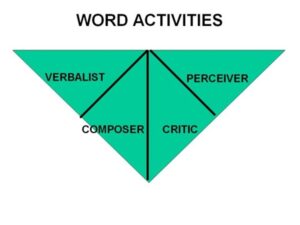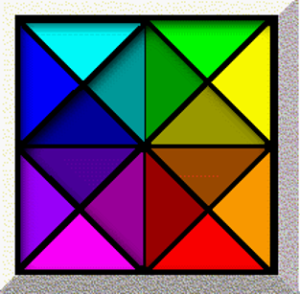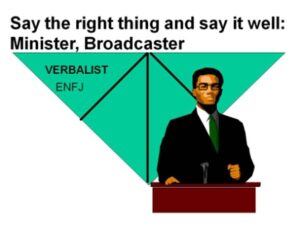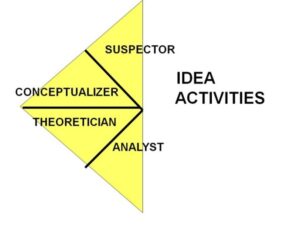This is now the fifth segment of articles on, How to understand people. If you have been following through the first four installments you are by now familiar with the basics of the chart I call The Map of Activity. In this lesson we be taking a closer look at the top of The Map of Activities; the triangular wedge we call WORDS. Here is a brief review.
The Map of Activities is divided top and bottom by the simple choice called FOCUS. On the top are PEOPLE and on the bottom are THINGS. The diagram is divided left and right by the simple choice of APPROACH. On the left is CONCRETE and on the right is ABSTRACT.
The letters S,F,N & T stand for the four FUNCTIONS of SENSING, FEELING, INTUITION, and THINKING. The combination of the first two choices of FOCUS and APPROACH is what makes for the choices of FUNCTIONS.
- FEELING chooses CONCRETE PEOPLE
- INTUITION chooses ABSTRACT PEOPLE
- SENSING chooses CONCRETE THINGS
- THINKING chooses ABSTRACT THINGS.
Two FUNCTIONS combine to create the activities of WORDS, IDEAS, HANDS, and BODY. There is a choice in each activity between INTROVERSION and EXTROVERSION. The former fall within the inside square of The Map of Activity while the latter are on the outside corners. The choice we have when dealing with the world is between gathering data (called PEERCIEVING) and making decisions (called JUDGING). At the conclusion of Part 4 we saw that the individual sections of The Map of Activity could be labeled with the 16 type names of Myers-Briggs type theory. Walter Lowen named them Transactional Rolls. I call them ACTIVITIES. They are the most conscious ACTIVITIES of the Myers-Briggs types. However, each type actually uses 8 of these ACTIVITIES in descending order of conscious awareness and skill. Therefore as you see in this graphic I have left out the four letter Type designation for the ACTIVITIES in order to reinforce the idea that they are used by many different Personality Types and not just the ones that we might see on the Map of Activities. This will become clear in future articles when we take each type and show which 8 ACTIVITIES they use.
The first WORD ACTIVITY that we will examine is called, VERBALIST. For review let us check of the list of simple choices that have led to this ACTIVITY.
- FOCUS = PEOPLE
- APPROACH = CONCRETE
- ENERGY = EXTROVERTED
- DOMINATE FUNCTION = FEELING
- DEALS WITH THE WORLD = JUDGING
People who use the VERBALIST ACTIVITY have the ability to be articulate. They know the right thing to say and say it well. Their Pitch and Tone are right on target and when they speak they are in tune with their audience’s feedback. Depending upon how strong their preferences are they may find it difficult to relinquish the opportunity to speak to others.
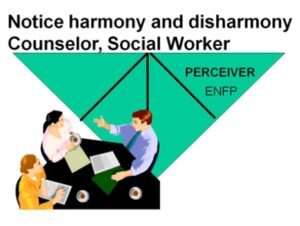
The other EXTROVERTED VEBALIST ACTIVITY is PERCIEVER. The simple choices that lead to this ACTIVITY are as follows.
- FOCUS = PEOPLE
- APPROACH = ABSTRACT
- ENERGY = EXTROVERTED
- DOMINANTE FUNCTION = INTUITION
- DEALS WITH THE WORLD = PERCIEVING
People who use the PERCIEVER ACTIVITY have the uncanny ability to use their 6th sense to observe harmony and disharmony with accuracy. Actually it can often be baffling to them as well as others. Yet they “know what they know” and it helps them be successful in people oriented professions like teaching, social work, counseling and the ministry. However, it is often said of ENFP personality types that “they can do anything they want to, if they would just make up their minds.”
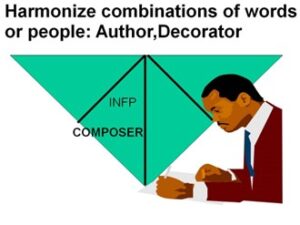
Next we will look at the two INTROVERTED ACTIVITIES, beginning with the one called CRITIC. The simple choices that lead to this ACTIVITY are as follows.
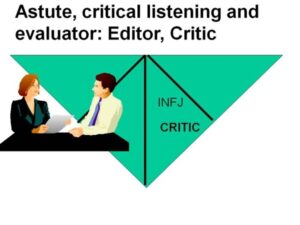
- FOCUS = PEOPLE
- APPROACH = ABSTRACT
- ENERGY = INTROVERTED
- DOMINATE FUNCTION = INTUITION
- DEALS WITH THE WORLD WITH JUDGING
People who use the CRITIC ACTIVITY are behaving in the opposite direction from the VERBALIST. They have very acute, critical listening, with exacting interpretation that notes the differences in meanings of words like “lied,” “falsified,” “distorted,” “misinterpreted,” and “misunderstood”. This ACTIVITY of CRITIC is vital to such professionals as speech therapists, voice coaches, theater critics, political analysts, interviewers, and copy editors.
Let’s me answer a question that you will ask sooner or later.
How do we decided which is the dominate function?
The answer has to do with the choice of dealing with the world between gathering data (PERCIEVING) and making decisions (JUDGING). EXTROVERTS are “out there” so they deal with the world with their dominate FUNCTION. Thus the dominate FUNCTION for and ENFJ is FEELING .
J and P are just a simple choice between the two data gathering FUNCTIONS of SENSING and INTUITION and the two deciding FUNCTIONS of FEELING and THINKING. By contrast the dominate FUNCTION for the INFJ is INTUITION because INTROVERTS keep their dominate function INTROVERTED and what the world sees in the AUXILIARY function. In the next step we look at the ACTIVITY known as CRITIC with the Personality Type label of INFJ. It’s dominate FUNCTION is FEELING because it shows the world its auxiliary function of extroverted INTUITION.

The last of the WORD ACTIVITIES is COMPOSER. The simple choices that lead to this ACTIVITITY are as follows.
The last of the WORD ACTIVITIES is COMPOSER. The simple choices that lead to this ACTIVITITY are as follows.
The last of the WORD ACTIVITIES is COMPOSER. The simple choices that lead to this ACTIVITITY are as follows.
FOCUS = PEOPLE
APPROACH = CONCRETE
ENERGY = INTROVERTED
DOMINATE FUNCTION =FEELING
DEALS WITH THE WORLD = PERCIEVING
People who use the COMPOSER AVTIVITY love to write WORDS. They are known to keep journals and these days they probably write blogs. However, their COMPOSING is not limited to words. People can become their “words” as they arrange parties, or plan weddings and vacations. They are also good at arranging flowers and decorating homes. This ACTIVITY is also sensitive to issues of human sensitivity and spirituality and so strong COMPOSERS make good psychologist and councilors.
It’s time once again to meditate and think about how these rolls apply to you and the people you know. Some will strongly reflect the picture painted here. You and others may only seem to use these ACTIVITIES from time to time. We will explain in later articles why this is true and how we use the ACTIVITIES at different levels of conscious awareness. Be looking for the next installment of How to understand people Part 6: IDEA ACTIVITIES.

